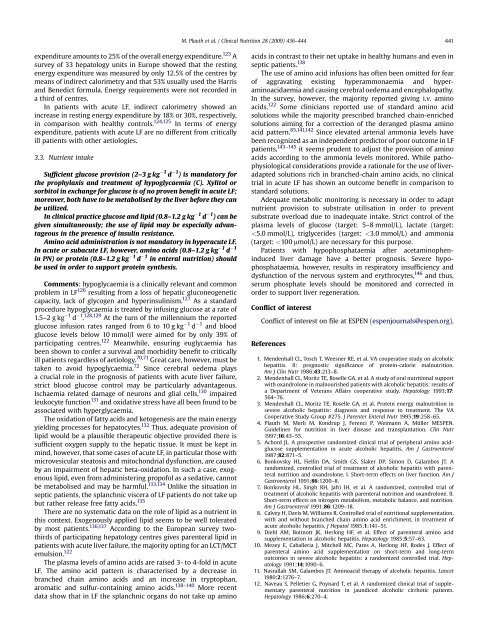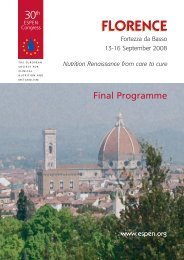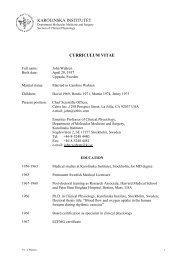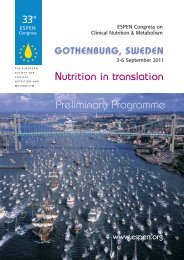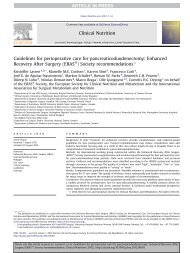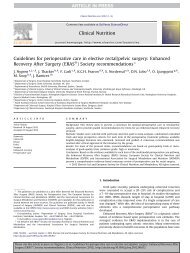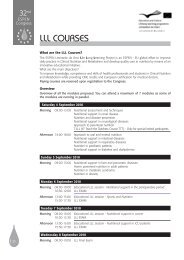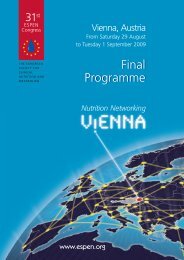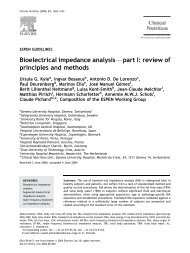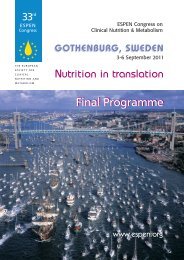ESPEN Guidelines on Parenteral Nutrition: Hepatology
ESPEN Guidelines on Parenteral Nutrition: Hepatology
ESPEN Guidelines on Parenteral Nutrition: Hepatology
Create successful ePaper yourself
Turn your PDF publications into a flip-book with our unique Google optimized e-Paper software.
expenditure amounts to 25% of the overall energy expenditure. 123 A<br />
survey of 33 hepatology units in Europe showed that the resting<br />
energy expenditure was measured by <strong>on</strong>ly 12.5% of the centres by<br />
means of indirect calorimetry and that 53% usually used the Harris<br />
and Benedict formula. Energy requirements were not recorded in<br />
a third of centres.<br />
In patients with acute LF, indirect calorimetry showed an<br />
increase in resting energy expenditure by 18% or 30%, respectively,<br />
in comparis<strong>on</strong> with healthy c<strong>on</strong>trols. 124,125 In terms of energy<br />
expenditure, patients with acute LF are no different from critically<br />
ill patients with other aetiologies.<br />
3.3. Nutrient intake<br />
Sufficient glucose provisi<strong>on</strong> (2–3 g kg 1 d 1 ) is mandatory for<br />
the prophylaxis and treatment of hypoglycaemia (C). Xylitol or<br />
sorbitol in exchange for glucose is of no proven benefit in acute LF;<br />
moreover, both have to be metabolised by the liver before they can<br />
be utilized.<br />
In clinical practice glucose and lipid (0.8–1.2 g kg 1 d 1 ) can be<br />
given simultaneously; the use of lipid may be especially advantageous<br />
in the presence of insulin resistance.<br />
Amino acid administrati<strong>on</strong> is not mandatory in hyperacute LF.<br />
In acute or subacute LF, however, amino acids (0.8–1.2 g kg 1 d 1<br />
in PN) or protein (0.8–1.2 g kg 1 d 1 in enteral nutriti<strong>on</strong>) should<br />
be used in order to support protein synthesis.<br />
Comments: hypoglycaemia is a clinically relevant and comm<strong>on</strong><br />
problem in LF 126 resulting from a loss of hepatic gluc<strong>on</strong>eogenetic<br />
capacity, lack of glycogen and hyperinsulinism. 127 As a standard<br />
procedure hypoglycaemia is treated by infusing glucose at a rate of<br />
1.5–2 g kg 1 d 1 . 128,129 At the turn of the millennium the reported<br />
glucose infusi<strong>on</strong> rates ranged from 6 to 10 g kg 1 d 1 and blood<br />
glucose levels below 10 mmol/l were aimed for by <strong>on</strong>ly 39% of<br />
participating centres. 122 Meanwhile, ensuring euglycaemia has<br />
been shown to c<strong>on</strong>fer a survival and morbidity benefit to critically<br />
ill patients regardless of aetiology. 70,71 Great care, however, must be<br />
taken to avoid hypoglycaemia. 72 Since cerebral oedema plays<br />
a crucial role in the prognosis of patients with acute liver failure,<br />
strict blood glucose c<strong>on</strong>trol may be particularly advantageous.<br />
Ischaemia related damage of neur<strong>on</strong>s and glial cells, 130 impaired<br />
leukocyte functi<strong>on</strong> 131 and oxidative stress have all been found to be<br />
associated with hyperglycaemia.<br />
The oxidati<strong>on</strong> of fatty acids and ketogenesis are the main energy<br />
yielding processes for hepatocytes. 132 Thus, adequate provisi<strong>on</strong> of<br />
lipid would be a plausible therapeutic objective provided there is<br />
sufficient oxygen supply to the hepatic tissue. It must be kept in<br />
mind, however, that some cases of acute LF, in particular those with<br />
microvesicular steatosis and mitoch<strong>on</strong>drial dysfuncti<strong>on</strong>, are caused<br />
by an impairment of hepatic beta-oxidati<strong>on</strong>. In such a case, exogenous<br />
lipid, even from administering propofol as a sedative, cannot<br />
be metabolised and may be harmful. 133,134 Unlike the situati<strong>on</strong> in<br />
septic patients, the splanchnic viscera of LF patients do not take up<br />
but rather release free fatty acids. 135<br />
There are no systematic data <strong>on</strong> the role of lipid as a nutrient in<br />
this c<strong>on</strong>text. Exogenously applied lipid seems to be well tolerated<br />
by most patients. 136,137 According to the European survey twothirds<br />
of participating hepatology centres gives parenteral lipid in<br />
patients with acute liver failure, the majority opting for an LCT/MCT<br />
emulsi<strong>on</strong>. 122<br />
The plasma levels of amino acids are raised 3- to 4-fold in acute<br />
LF. The amino acid pattern is characterised by a decrease in<br />
branched chain amino acids and an increase in tryptophan,<br />
aromatic and sulfur-c<strong>on</strong>taining amino acids. 138–140 More recent<br />
data show that in LF the splanchnic organs do not take up amino<br />
M. Plauth et al. / Clinical Nutriti<strong>on</strong> 28 (2009) 436–444 441<br />
acids in c<strong>on</strong>trast to their net uptake in healthy humans and even in<br />
septic patients. 138<br />
The use of amino acid infusi<strong>on</strong>s has often been omitted for fear<br />
of aggravating existing hyperamm<strong>on</strong>aemia and hyperaminoacidaemia<br />
and causing cerebral oedema and encephalopathy.<br />
In the survey, however, the majority reported giving i.v. amino<br />
acids. 122 Some clinicians reported use of standard amino acid<br />
soluti<strong>on</strong>s while the majority prescribed branched chain-enriched<br />
soluti<strong>on</strong>s aiming for a correcti<strong>on</strong> of the deranged plasma amino<br />
acid pattern. 85,141,142 Since elevated arterial amm<strong>on</strong>ia levels have<br />
been recognized as an independent predictor of poor outcome in LF<br />
patients, 143–145 it seems prudent to adjust the provisi<strong>on</strong> of amino<br />
acids according to the amm<strong>on</strong>ia levels m<strong>on</strong>itored. While pathophysiological<br />
c<strong>on</strong>siderati<strong>on</strong>s provide a rati<strong>on</strong>ale for the use of liveradapted<br />
soluti<strong>on</strong>s rich in branched-chain amino acids, no clinical<br />
trial in acute LF has shown an outcome benefit in comparis<strong>on</strong> to<br />
standard soluti<strong>on</strong>s.<br />
Adequate metabolic m<strong>on</strong>itoring is necessary in order to adapt<br />
nutrient provisi<strong>on</strong> to substrate utilisati<strong>on</strong> in order to prevent<br />
substrate overload due to inadequate intake. Strict c<strong>on</strong>trol of the<br />
plasma levels of glucose (target: 5–8 mmol/L), lactate (target:<br />


